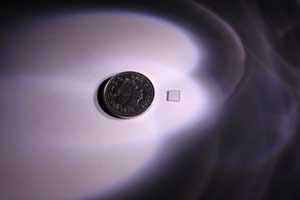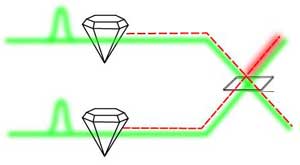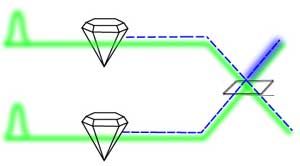Entangled Diamonds
Quantum entanglement has been called "spooky action at a distance" by Einstein and has often been called spooky or weird since then. Recently two diamonds, big enough to see with your eye, were observed to have entangled quantum mechanical states. This is the first time solid objects at room temperature have been measured to be in an entangled state!1-4 It’s a big deal! Read on to learn about quantum weirdness, entanglement, and this experiment.
 (a) |
 (b) |
Figure 1. (a) Experimental equipment used to measure entangled diamonds. (b) Diamond used in experiment. |
|
Quantum weirdness
On the atomic scale physicists use quantum mechanics to describe the physical properties of objects and predict outcomes of measurements. Quantum mechanics was created because the classical ways of describing things, which includes Newton’s laws, were failing when applied to very small things like atoms. Quantum mechanics is excellent in predicting and describing so many observable phenomena on the atomic scale. It hasn’t failed yet! Unfortunately, it has some strange things built into it that make even experts in the field ponder its weirdness. Many of the founders of quantum mechanics were unhappy with it. You may have heard about some of the weirdness that results from a quantum mechanical approach.
The not weird, but important Heisenberg's Uncertainty Principle: You can never know exactly where something is and how fast it is going at any instant because the act of measuring causes the object’s speed or location to be altered. This holds true for all systems of variables related to each other in a special way. Frequency and time are examples of related variables, and the energy of a state in quantum mechanics is directly related to the frequency, so energy and time are related too.
Superposition of States and Schödinger's Cat: Place a cat in a closed box with a lethal substance in a very breakable container. Describe the state of the cat without taking any measurement. Quantum mechanics describes the cat as dead and alive simultaneously! The description of the cat’s state before it is measured is said to be in a superposition of states. It is the act of measurement that forces the cat to be in a single state, hopefully alive! You may want to look at this short video of the effect created by Kwiat's research group at University of Illinois Urbana-Champaign
 Figure 2. A cat in a box would be described as a superposition of states between dead and alive, but once the box is opened, the measurement causes the cat to be forced into a state.
Figure 2. A cat in a box would be described as a superposition of states between dead and alive, but once the box is opened, the measurement causes the cat to be forced into a state. Image Credit: Wikimedia Commons
Einstein, Podolsky, Rosen (EPR) Paradox and Entanglement: This originated as a thought experiment designed to point out some of the concerns of quantum mechanics. Think about one system with its very own "wave function" that describes its physical state. Then consider transforming this single system to two systems located apart from each other. These two systems don't have two identical wave functions. Instead the two systems share the original wave function, and are connected, or entangled even over very, very, long distances. An example of this might be one particle decaying into two new particles, or an atom with extra internal energy emitting that energy in the form of a packet of light energy (photon). The two new objects can travel in any old direction as long as they travel in such a way that the sum of their momenta (mass times velocity) is the same as the initial object’s momentum, and the sum of their energies (plus any that may have went into the surroundings) is the same as the energy of the initial object. If one of the objects interacts with something else, then things change. For the entanglement to last they can’t interact with anything else as they move very, very far away from each other. Measure the velocity of one object, and the other object’s velocity is known with certainty before even measuring it. This entanglement between objects allows you to sometimes make better measurements than if the objects were not entangled. If you measure the velocity of the first particle and the location of the second particle you can know the velocity and location of each particle.
Entanglement may be considered as not being able to determine the exact physical origin causing the outcome of a measurement, so you always have to describe the state before the measurement as a superposition of possible states, like Schrödinger's Cat. For example if you have a single packet of light energy (photon) go through a 50-50 beam splitter (partially reflective glass), the photon has a 50% chance of reflecting off the beam splitter and a 50% chance of going through the beam splitter. The photon after the beam splitter is an entangled state described by a superposition of the photon going through and reflecting off of the beam splitter. If a detector is set up on each pathway, then only one of the detectors will register a photon, and it is impossible to predict which one. The measurement "collapses" the photon wave function into one of the two possibilities at random on each trial of the experiment. You cannot learn from this measurement whether the photon is in an entangled state or not, just as you cannot know whether the cat was in a superposition state before you learned whether it was alive or dead. If, however, a second beam splitter is set up to recombine the two paths, and a detector measures the photon after the two paths have been combined, then the photon will always end up going the same way out of the second beam splitter. This is a signature that they are entangled, and provides proof of entanglement. This is just what has been done with these two macroscopic diamonds!
The big deal about entangling two diamonds
In quantum mechanics this connection between entangled states can easily be disrupted by the many other interactions from the many other objects around. Designing an experiment to measure entanglement isn’t the easiest, but certainly is possible and has been done a number of times. The big deal is that it’s never before been done with solid objects at room temperature. The Ultrafast Quantum Optics Group at the University of Oxford set up two diamonds near each other (15 cm apart) on a lab table (Figure 1a), and did not change any other environmental condition (like temperature or pressure). Diamonds are made of carbon atoms arranged in a special way. The research group selected a strong laser pulse with a frequency just right for being absorbed by a carbon atom in a diamond, and through another process (Raman scattering) results in a slightly lower frequency photon (packet of light energy) being emitted and an increase in one of the diamond’s vibrational energy states. The slightly lower frequency light emitted is said to be red-shifted. The extra internal vibrational energy is quickly distributed over the carbon atoms in diamonds because of the way the carbon atoms are placed (lattice structure) to make a diamond.
The laser pulse was sent through a 50-50 beam splitter toward the two diamonds so both diamonds were simultaneously pumped with light (50% going toward the first diamond, 50% going toward the second diamond). If energy is absorbed from the laser pulse, the diamond’s vibrational state would increase, and red-shifted (lower frequency) light energy would be emitted. This red-shifted light provides evidence that a vibrational state exists in the diamond. They combined the red-shifted light from both possible paths and measured it with a detector (Fig 3a). By measuring exactly one red-shifted photon (packet of light energy) they were able to infer that the two diamonds should be entangled: they know that one of the diamonds has extra vibrational energy (and emitted the photon), but they can’t tell which one.
 (a) |
 (b) |
| Figure 3.(a) Generating an entangled state: A single laser pulse pump beam goes through a 50-50 beam splitter and simultaneously pumps the top diamond and the bottom diamond. Energy is absorbed from the pump pulse by the diamond(s), causing an increase in internal vibrational energy and the emission of red-shifted light (lower frequency than the pump beam). The red-shifted light from the two paths is combined and measured. (b) Verifying entanglement: A probe laser pulse (different from the pump pulse) goes through the 50-50 beam splitter and simultaneously probes the top diamond and the bottom diamond. When it reaches a diamond it causes the diamond to give up its extra vibrational energy and emit light with a higher frequency (blue-shifted) than the probe field. The blue-shifted light from the two paths is combined and measured. Image credits: Ian Walmsley’s Ultrafast quantum optics and optical metrology lab at the University of Oxford |
|
To verify the entangled state the researchers decided to probe the increased vibrational energy state of the diamonds. To do this they would have to send a laser probe beam to the diamonds before the diamonds transferred their vibrational energy to the environment, before the diamonds have a chance to decohere. The increased vibrational energy state of a diamond is short lived. A diamond crystal will give up its energy to its surroundings in the average time of 7 picoseconds or 7 trillionths of a second. Scientists call this the average decay time or lifetime of the increased energy state. Seven trillionths of a second was not a problem for this ultrafast optical lab! They were able to probe this vibrational state by sending a second, ultrafast, laser probe pulse within about 0.35 picoseconds (0.35 trillionths of a second) from the initial laser pulse. When the probe laser pulse reaches a diamond in an increased vibrational state, it causes the diamond to emit its extra energy resulting in a decreased vibrational energy state of the diamond, and the emission of a photon with a higher frequency than the probe. The higher frequency photon is said to be blue-shifted. Both possible paths of the blue-shifted light are combined and measured (Fig 3b).
There is no way to know which diamond the red and blue shifted light came from, which means the diamonds must be described as sharing a vibrational state. The information from the measurements of the red-shifted and blue-shifted light provides a lower limit on the entanglement of the vibrational states of the two diamonds. If the red-shifted and blue-shifted photons are entangled, then the vibrational states of the diamond are entangled by at least the same amount. The coincident count of the two types of photons were measured and found to be highly correlated, indicating highly correlated vibrational energy states of the two diamonds. By analyzing their results to see how related these two measurements were, they found entanglement between the diamonds to be 0.85, where perfect entanglement is equal to 1.00!1 This means that when describing the two diamonds' vibrational energy, they must be described as sharing a single quantum of vibrational energy.
Future research and applications
Quantum entanglement is used in quantum communication, quantum teleportation, quantum computing, and quantum cryptography. The results of this experiment demonstrating entanglement may be used for further tests on the fundamentals of quantum mechanics, and will have implications for the applications listed above that utilize entanglement.
References, resources, and links
1. Lee, K.C. et al. Entangling Macroscopic Diamonds at Room Temperature, Science 334, 1253 (2011).
2. Duan, L-M. Quantum Correlation Between Distant Diamonds, Science, 334, 1213 (2011).
3. Matson, J. Quantum Entanglement Links 2 Diamonds, Scientific American, Dec 2011.
4. Walmsley, I. and Nunn, J., Entang-bling, 2Phyiscs, 25 December 2011
http://www.2physics.com/
5. Ian Walmsley, Clarendon Laboratory, Dept. of Physics, University of Oxford, UK
http://www2.physics.ox.ac.uk/research/ultrafast-quantum-optics-and-optical-metrology
6. Betz, Eric. Quantum Migration
H.M. Doss














